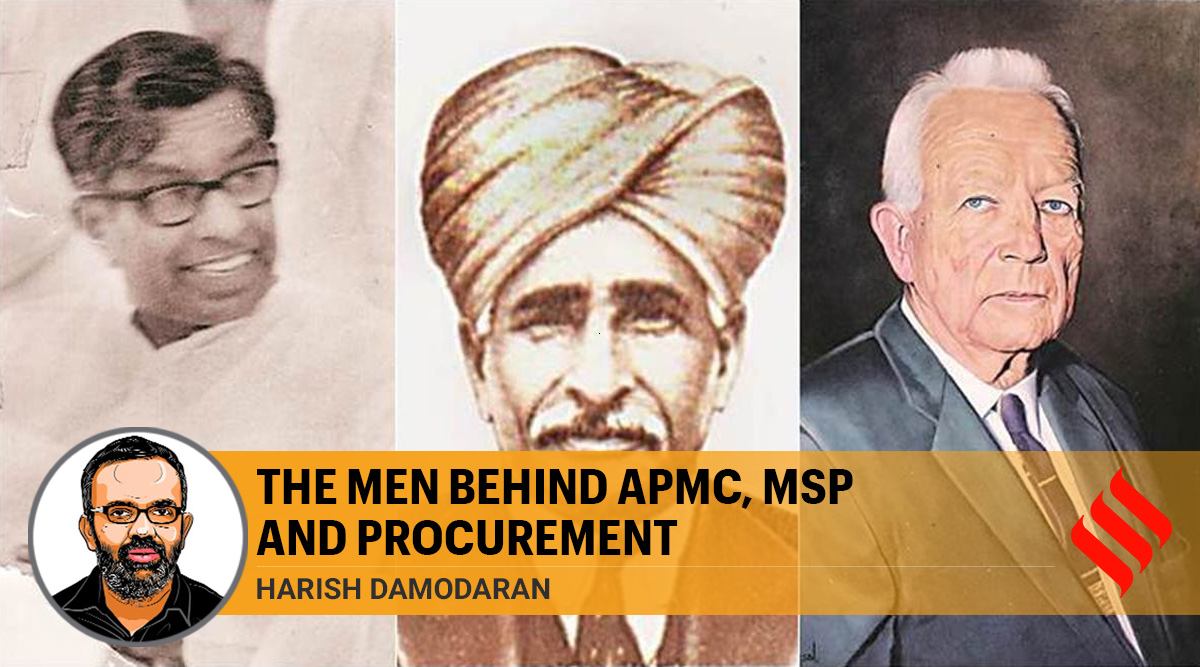 The APMC mandis may not have measured up to Chhotu Ram’s expectations; middlemen have found ways around to continue to keep farmers under their thumbs.
The APMC mandis may not have measured up to Chhotu Ram’s expectations; middlemen have found ways around to continue to keep farmers under their thumbs.
The institution of ‘mandis’ is as old as markets where wholesale trading in primary produce has been taking place since time immemorial.
APMCs or Agricultural Produce Market Committees are of more recent vintage and the creation of Sir Chhotu Ram. In 1939, the legendary farmer leader, as Development Minister in the provincial government of his Unionist Party, got the Punjab Agricultural Produce Markets Act passed. It provided for the constitution of “market committees” having two-thirds farmer representation to oversee the functioning of mandis and curb malpractices by traders. This was complemented by another law that made the use of false or non-standard weights and scales in mandis a cognizable offence.
Thus, “mandis” became “APMC mandis”. In course of time, almost all states enacted their own APMC Acts to regulate mandis and outlaw any wholesale transactions in farm produce outside these market yards or “notified areas”. At last count, there were over 7,300 APMC mandis, both principal and sub-market yards, across India.
The origin of MSPs or minimum support prices is even newer. Its progenitor was an American, Dr Frank W Parker, who was the chief agriculturalist of a USAID (US Agency for International Development) mission to India and adviser to the Ministry of Food and Agriculture.
In a letter dated February 1959 to the then minister Ajit Prasad Jain, Parker pointed to the problem of low crop prices faced by farmers during harvest time. It deterred them from investing in good seeds, fertilisers and other productivity-boosting inputs. “One of the greatest economic incentives for production is a satisfactory and dependable level of prices,” he wrote, while recommending that the government “establish minimum or support prices for all major crops at least one year before harvest”.
But the man to have implemented Parker’s idea was C Subramaniam, who took over as Food and Agriculture Minister in June 1964. Like Chhotu Ram, a Jat, he too hailed from a peasant community, of Kongu Vellalar or Gounder, in western Tamil Nadu.
Subramaniam was clear that the adoption of Green Revolution technology — particularly the planting of the new semi-dwarf high-yielding varieties responsive to fertiliser and water application — required not only declaring MSPs in advance, but also ensuring farmers were paid these through effective government procurement.
One of the first things Subramaniam did was seek approval for the policy of an incentive price for farmers. There was heated debate over the paper he had prepared for the Cabinet. The opposition came from Finance Minister T T Krishnamachari, who was predictably concerned over the attendant fiscal and inflationary consequences. Ultimately, Subramaniam’s view prevailed, thanks to the support received from Prime Minister Lal Bahadur Shastri. For a country leading a ship-to-mouth existence — cereal imports totalled over 19 million tonnes (mt) in 1965-66 and 1966-67, both drought years — there was little alternative.
Subramaniam was also instrumental in the founding of two major institutions, both in January 1965. The first was the Agricultural Prices Commission, which was renamed as the Commission for Agricultural Costs and Prices or CACP in 1985. It was tasked with recommending MSPs based on a detailed study of cultivation costs. The MSP was fixed for the first time for wheat at Rs 54 per quintal in 1966-67 and hiked to Rs 70 and Rs 76 in the following two crop years.
The second one was the Food Corporation of India (FCI). Its role was to organise countrywide MSP-based procurement operations. In 1968, the FCI procured 6.8 mt of foodgrains, which rose to 13.3 mt by 1975-76. Much of this was done from APMC mandis during the few months of the post-harvest glut period when prices usually crashed.
Many harvests have passed since then. Between 1970-71 and 2019-20, the MSPs of wheat and common paddy have gone up from Rs 76 and Rs 51 per quintal to Rs 1,925 and Rs 1,815, respectively. In 2019-20, the FCI and state agencies procured a whopping 90.22 mt — 38.99 mt of wheat and 51.23 mt of milled rice — whose aggregate MSP value was roughly Rs 2,15,000 crore.
The APMC mandis may not have measured up to Chhotu Ram’s expectations; middlemen have found ways around to continue to keep farmers under their thumbs. But farmers, especially in Punjab and Haryana, know the value of the institutions that the Jat icon and Subramaniam bequeathed. They have shown it in the protests against the Narendra Modi government’s recently enacted laws that ostensibly aim to liberate them from mandi intermediaries. The APMCs, MSP and FCI are lifelines for them, while the arhatiya isn’t quite an implacable class enemy.
The one man less remembered today is Frank W Parker. The Punjab Agricultural University campus at Ludhiana has a 96-room guest house named after him. Parker House more recently also served as a Covid quarantine facility for students and NRIs returning back home.
📣 The Indian Express is now on Telegram. Click here to join our channel (@indianexpress) and stay updated with the latest headlines
For all the latest Opinion News, download Indian Express App.
© The Indian Express (P) Ltd
"behind" - Google News
September 27, 2020 at 10:24AM
https://ift.tt/3j6ytuj
The men behind APMC, MSP and procurement - The Indian Express
"behind" - Google News
https://ift.tt/2YqUhZP
https://ift.tt/2yko4c8
Bagikan Berita Ini














0 Response to "The men behind APMC, MSP and procurement - The Indian Express"
Post a Comment